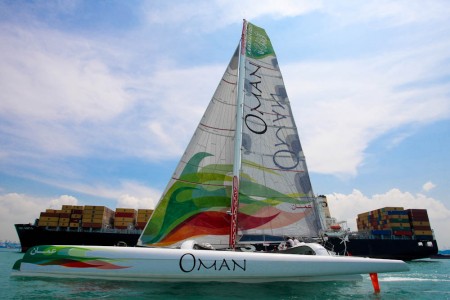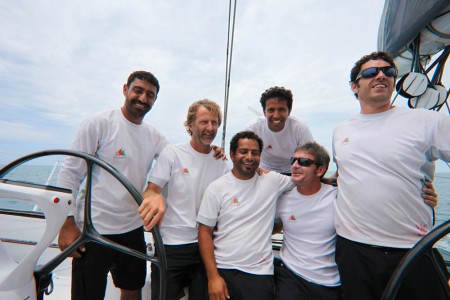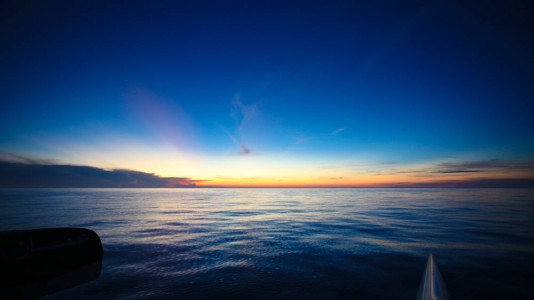
For the crew on board Oman Sail’s A100 trimaran ‘Majan’ the departure from the penultimate stopover in Singapore, proved a poignant moment as they set out on the final leg to cover the final 3,200 miles (5,900km) of this new Indian Ocean 5 Capes Race course. Eager to reach their homeport of Muscat, Oman, but at the same time knowing this was the last stopover of the tour. The Oman Sail team, who have been promoting the Indian Ocean 5 Capes Race ahead of the first official planned edition in 2012 as well as the new A100 class of boat, have been warmly received at every stopover from the Maldives, Cape Town to Fremantle and, lastly, Singapore.
‘Majan’ spent just over a week in Singapore showcasing Majan to the local media and VIP guests and left Keppel Bay Marina on Tuesday, 27th April to cross the start line of leg 5 south of Cape Piai: “On a beautiful day with 6 knots from a westerly direction we crossed the line to the south of Cape Piai at 04:00 UCT, midday local time,” reported media crew, Mark Covell. “Now, as we pick our way northwards up the course, we enter the Malacca Straits. With Malaysia to the East and Sumatra to the west, the straits get slowly wider, starting at 35nm and opening out to 145nm.” From an economic and strategic perspective the Strait of Malacca is one of the most important shipping lanes in the world, being the main shipping channel between the Indian Ocean and the Pacific Ocean, linking major Asian economies such as India, China, Japan and South Korea. Over 50,000 vessels pass through the strait per year.
Mark further explains the route to Muscat: “In about 600 miles we can turn to port and round Banda Aceh, northern Indonesia and head out to Sri Lanka. After passing Sri Lanka, we will carve around the bottom of Cape Cormorin [the final Cape on the Indian Ocean 5 Capes Race course], the southern most tip of India, which will be the last sight of land before seeing Oman. We will then race as fast as we can to the finish line off Cape Ras Al Hadd to enter the Gulf of Oman and home to Muscat. By then we will have raced over 16,000 sailing miles.”
The international crew led by skipper Paul Standbridge includes Frenchman Sidney Gavignet, Mark Covell, Mohsin Al Busaidi, Mohammed al Ghailani and they will now be joined by fellow Omani and Oman Sail’s academy instructor, Ali Hamad Ambusaidi: “I wished that one day I could sail on Majan, now I have the chance to do it. It’s an honour to be one of the crew. I look forward to learning a lot and seeing things I have only dreamed of before.”

The Oman Sail Majan crew will be eager to reach home having left Muscat nearly three months ago on the 16th February. “We are all looking forward to reaching Muscat. Mohsin and Mohammed have not seen their family and friends since we left. Mohsin’s wife is expecting a new baby very soon after we get back, so the homecoming will be very special indeed,” said Mark. The final leg of the Indian Ocean 5 Capes Race is expected to arrive in the first week of May.
About Cape Comorin:
Today known under the name of Kanyakumari, that tip of the Tamil Nadu State is the southernmost one of the Indian Peninsula and sits at the confluence of the Gulf of Mannar, the Arabian Sea and the Indian Ocean. Taking its name from the Kumari Amman Temple, this cape has been widely documented and is at the heart of numerous mythical episodes. Mentions of Comorin can be found in the works of Claudius Ptolemaeus (Ptolemy), the famous Greek geographer and mathematician, who notably produced a detailed – if not completely accurate – world description in his Geographia. Among the numerous legends linked with the place, one has it that the rocks scattered around the cape are grains that remained uncooked when the wedding between Hindu deity Shiva and Kanya Devi failed to happen: the husband-to-be never showed up, and the rice gradually turned to stone… But perhaps the most interesting story is that of Kumari Kandar, a mythical continent (or sunken landmass) which has long been believed to face the cape, its triangular shape pointing northwards taking up almost all of the Indian Ocean! Kanyakumari (Comorin) has always been an important commercial, cultural and spiritual centre, famous for its pearl fishing and beautiful temples which grant it today a special attraction power when it comes to tourism.
Coordinates: 8°07’ N – 77°54’ E
More on The Strait of Malacca:
From an economic and strategic perspective the Strait of Malacca is one of the most important shipping lanes in the world, being the main shipping channel between the Indian Ocean and the Pacific Ocean, linking major Asian economies such as India, China, Japan and South Korea. Over 50,000 vessels pass through the strait per year, carrying about one-quarter of the world’s traded goods including oil, Chinese manufactures, and Indonesian coffee.
At Phillips Channel close to the south of Singapore, the Strait of Malacca narrows to 2.8 km (1.5 nautical miles) wide, creating one of the world’s most significant traffic choke points. There are 34 shipwrecks, some dating to the 1880s, in the Traffic Separation Scheme (TSS), the channel for commercial ships. These pose a collision hazard in the narrow and shallow parts of the Straits.
The Strait of Malacca is a narrow, 805 km (500 mile) stretch of water between Peninsular Malaysia (West Malaysia) and the Indonesian island of Sumatra. It is named after the Empire of Melaka that ruled over the archipelago between 1414 to 1511.
